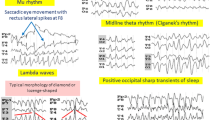Abstract
Electrical activity of the duodenal smooth muscles was studied with the aid of permanently implanted electrodes. This activity was compared in the fasting state and at a time after feeding equal to the duration of the resting period and the period of activity of the duodenum outside digestion. Duodenal activity after feeding, as reflected in the number of pace-setting potentials, corresponded to its fasting activity. Duodenal activity during digestion differed considerably as regards the number of spike volleys outside digestion. The ratio between “digestive” and ‘fasting” duodenal electrical activity depended on the type of potentials and the periods of time compared. The optimal nature of “digestive” activity of the duodenal smooth muscles is evidently reflected in the fact that this activity fluctuates within certain limits during digestion: between maximal activity during the period of work and minimal activity during the period of rest outside digestion.
Similar content being viewed by others
Literature Cited
S. V. Anickhov, Nervol. Vestinik (Kazan'),21, No. 3, 861 (1914).
I. P. Ashmarin, N. N. Vasil'ev, and V. A. Ambrosov, Rapid Methods of Statistical Analysis and Planning of Experiments [in Russian], Leningrad (1975).
V. N. Boldyrev, Bol'nichnaya Gazeta Botkina, No. 34, 1529 (1902).
N. N. Lebedev, Physiology and Pathology of Periodic Activity of the Digestive Tract [in Russian], Moscow (1967).
A. P. Mukhina, “Duodenal motor activity under normal and pathological conditions”, Author's Abstract of Candidate's Dissertation, Moscow (1966).
V. N. Ustinov and V. I. Kotel'nikova, Fiziol. Zh. SSSR, No. 2, 284 (1971).
V. N. Ustinov, Fiziol. Zh. SSSR, No. 6, 961 (1974).
G. L. Allen, E. W. Poole, and C. F. Code, Am. J. Physiol.,207, 906 (1964).
P. Bass, in: Handbook of Physiology, Alimentary Canal, Vol. IV, Washington (1968), p. 2051.
E. J. McCoy and K. D. Baker, Am. J. Physiol.,214, 1291 (1968).
E. J. McCoy and P. Bass, Am. J. Physiol.,205, 439 (1963).
J. H. Szurszewski, Am. J. Physiol.,217, 1757 (1969).
N. W. Weisbrodt, Int. Rev. Sci. Physiol. Ser.,4, 157 (1974).
Rights and permissions
About this article
Cite this article
Shemerovskii, K.A. Effect of feeding on electrical activity of the duodenal smooth muscles in dogs. Bull Exp Biol Med 86, 1274–1277 (1978). https://doi.org/10.1007/BF00800433
Received:
Issue Date:
DOI: https://doi.org/10.1007/BF00800433




